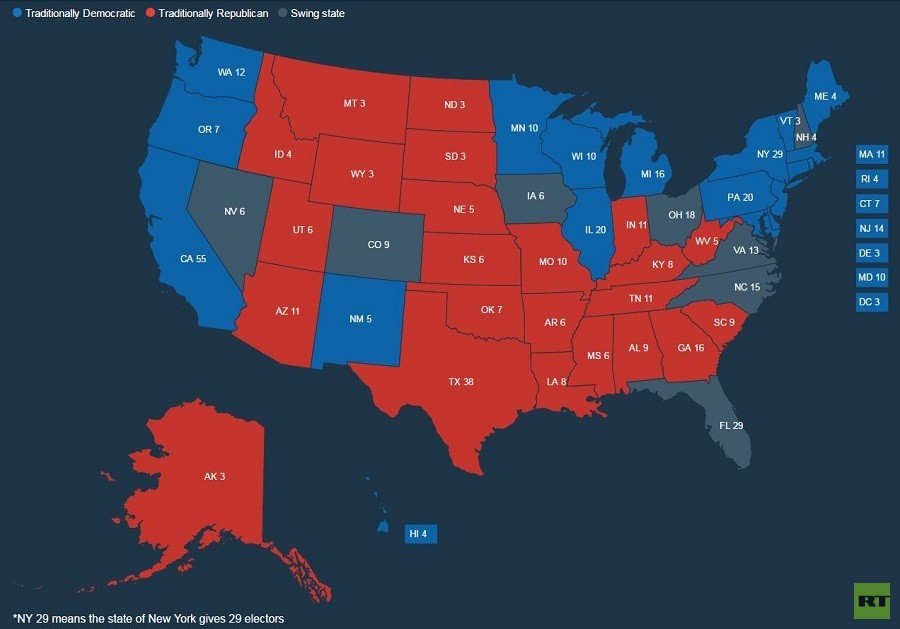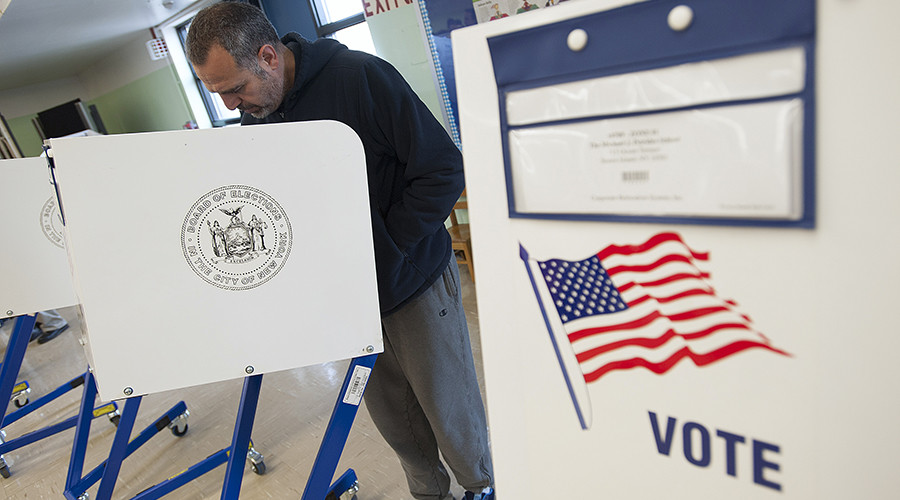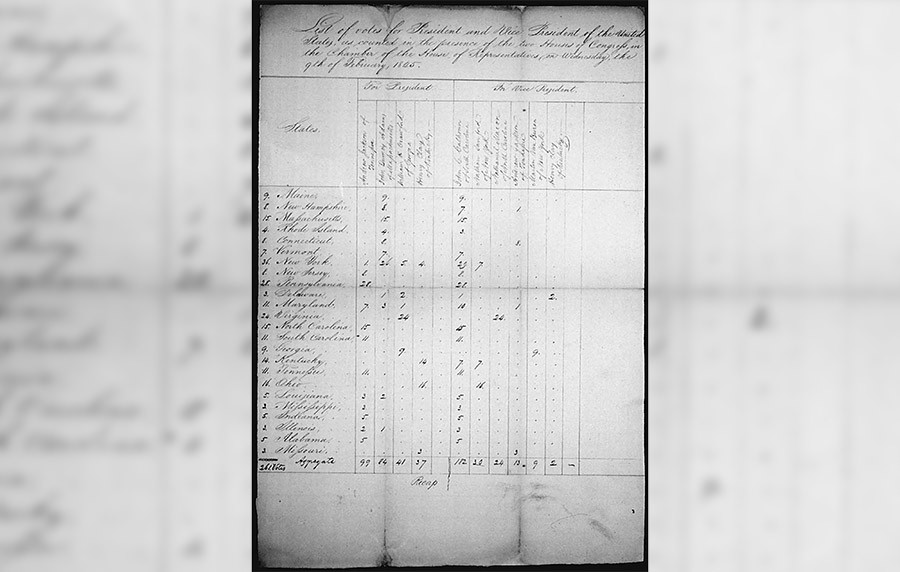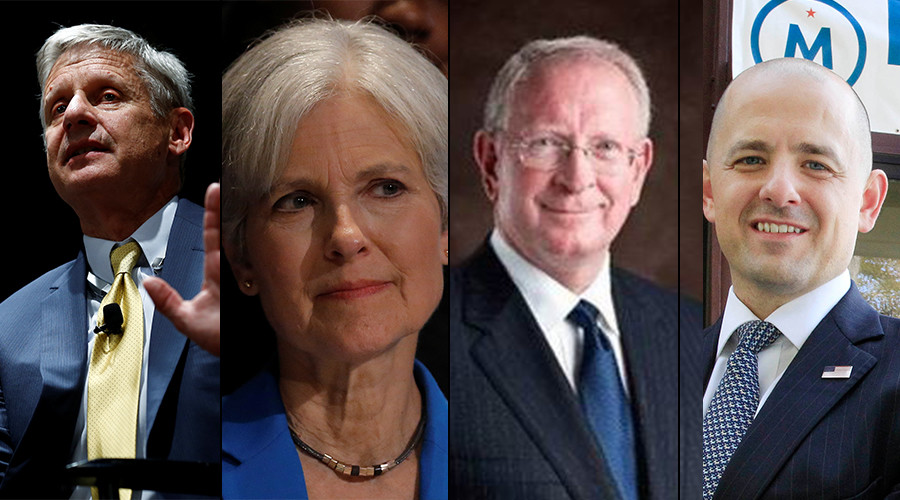Breaking down
the US elections: Your biggest questions answered
Published time:
8 Nov, 2016 00:22Edited time: 8 Nov, 2016 00:24
© Keith Bedford
/ Reuters
Just like with
the Olympic sport of curling, the US presidential election is full of rules and
terms that need to be relearned every four years. The race for the White House
isn’t the only one happening, though, and each contest has its own set of rules
The US is a
constitutional republic with indirect democracy. When people go to the polls
this year, they won’t just select who they want to run the country, but they
will also choose who they want to serve their congressional district in the
House of Representatives. A third of the country will also vote in senatorial
elections, while state and local positions may also be on the ballot, as well
as ballot initiatives and referendums.
The people will
not directly elect the president, however, and that can lead to a lot of
confusion. First, each political party selects its nominee, usually through
the primary and caucus system. Then the
citizens vote. Finally, the Electoral College selects the next US president,
based on how people vote in each state.
Who gets to
vote?
At the federal
level, any naturalized or native-born US citizen at least 18 years of age is
eligible to vote, as long as they are registered to do so. Beyond that, each
state has its own rules regarding
the eligibility of convicted felons, whether
voters are required to show a photo ID and more. Americans living abroad and in
the military are still able to vote, usually by an absentee ballot that is
mailed in. Registered voters who cannot go to the polls on November 8 can also
vote via absentee ballot or, in some states, in person during an early voting
period that begins up to 46 days before Election
Day. In Minnesota and Wisconsin, early voters
are able to change or “spoil” their votes under specific
circumstances.
What is the
Electoral College and how does it work?
The candidate
who wins the election may not be the person who won the popular vote, which is
based on the total number of votes cast throughout each country. George W. Bush
in 2000 was the most recent example of an election winner who lost the popular
vote. Instead, victory is based on the 538 members of the Electoral College,
each of whom represent a state or the District of Columbia based on population.
The number of electoral voters a state gets is equal to its representation in
Congress, with a minimum of three (Delaware, DC, Montana, North Dakota, South
Dakota, Vermont and Wyoming) and a maximum of 55 (California). The winning
candidate must receive at least 270 votes in the Electoral College.
Although
representation in the Electoral College is based on a state’s representation in
Congress, the Constitution specifically prevents any “Senator
or Representative, or Person holding an Office of Trust or Profit under the
United States”from serving as an elector. Instead, the political parties
choose a slate of electors for each state. Voters then choose the electors that
will represent their state in the Electoral College. Electors’ names may or may
not appear on the ballot below the presidential candidates, depending on the
state, according to the National Archives.

In Maine and
Nebraska, the electoral votes are split by congressional district, with the
winner of the state’s popular vote gaining the two statewide votes.
Traditionally, any districts that opt for the losing candidate will cede their
votes to the winner. In the remaining 48 states, the electoral votes are
winner-take-all. There are no federal laws that require electors vote with
their state’s popular vote, but several states have enacted such requirements.
In other states, electors are bound by pledges to the political parties to do
so. No elector has ever been prosecuted for failing to vote as they
pledged, according to the US
National Archives, but at least two electors have done so, once in 1972 and
once in 1976.
What’s a “swing
state”?
A swing state,
also known as a battleground state, is one that does not historically vote with
one major political party or the other. The current swing states (and their
electoral votes) are: Colorado (9), Florida (29), Iowa (6), Nevada (6), New
Hampshire (4), North Carolina (15), Ohio (18) and Virginia (13). Although they
have voted for the Democratic candidate since at least 1992, some
political analysts consider Michigan (16), Pennsylvania (20) and Wisconsin (10)
to be current battlegrounds as well. Candidates tend to spend a lot of time and
money in those states, as they are often the deciding factors in the election.
In fact, no Republican has won the White House without also winning Ohio since the
party was established in 1854.
What happens if
no one gets 270 electoral votes?
Historically “blue” states
‒ those that
have voted for a Democrat in at least the last five presidential elections ‒ total 247 electoral votes, while “red” states ‒ those that historically vote for a Republican ‒ total 191 electoral votes. Swing states have a total
of 100 electoral votes up for grabs. It is possible, though improbable, that
neither candidate will snag the required number of votes to win the presidency.
At that point, it heads to Congress to decide who will enter the White
House, according to the 12th
Amendment of the Constitution.
The House of
Representatives will vote for the next president from among the top three
candidates. The Senate will vote for the next vice president from among the top
two candidates. This has happened once in US history: In 1824, no candidate won a majority of the
Electoral College, so the House elected John Quincy Adams as president. At that
point in time, candidates did not run as a combined presidential and vice
presidential ticket, and John C. Calhoun won the vice presidency outright.
Tally of the
1824 Electoral College Vote © National Archives
What about
these “third parties” I keep hearing about?
As mentioned
above, if no one wins a majority in the Electoral College, the House of
Representatives will select the next president from the top three vote-getters.
Although much of the focus has been on Democratic nominee Hillary Clinton and
Republican Donald Trump, there are nearly 1,800 people who have filed with the Federal Election
Commission (FEC) as candidates. There are a total of 31
individuals who are on at least one state ballot; of those candidates, 13 are
on multiple ballots and only three (Clinton, Trump and Libertarian Party
nominee Gary Johnson) are on the ballot in all 50 states. Green Party
nominee Jill Stein is on the ballot in 44
states and has achieved write-in status in another three. Constitution Party
Darrell Castle nominee is on the ballot in 24
states and is a write-in candidate in 22 other states. Another candidate to
watch is Evan McMullin, an
independent, who could make a play for his home state of Utah and its six
electoral votes.
The popular
vote does matter when it comes to third parties, however. If a third-party
candidate receives 5 percent of the vote, then their party is eligible to receive federal grants from the
FEC in the 2020 general election. Candidates may retroactively qualify for
public funds if they receive 5 percent of the popular vote this year.
The main
third-party candidates: Gary Johnson, Jill Stein, Darrell Castle, and Evan
McMullin © Reuters
Are US
representatives and senators on the ballot?
Presidents are
elected to four-year terms; they are limited by the 22nd Amendment from
serving more than two terms. They have to deal with the legislative branch,
which has different terms. In the lower chamber, the House of Representatives,
lawmakers serve two-year terms, with all 435 seats up for election every two
years. In the upper chamber, the Senate, lawmakers serve six-year terms, and
only a third of seats are up for election during any one election cycle.
Neither chamber has term limits. Representatives serve congressional districts
within each state that are based on population, while two senators represent
each state.
During this
election cycle, seven Democratic and 22 Republican senators are running for reelection, while another
three Democrats and two Republicans are retiring and leaving their seats up for
grabs. Only 12 of the races are considered competitive, and the Democrats need
win just five of them to take control of the Senate.
What about
people in DC and in US territories?
US citizens
living in the nation’s capital or in the American territories of American
Samoa, Guam, Northern Mariana Islands, Puerto Rico and the US Virgin Islands do
not have voting representation in Congress. DC residents, however, are eligible
to vote for president, and receive three votes in the Electoral College. Those
living in US territories are not eligible to vote for president, but they are
able to participate in the primary process.
Tim Kaine is a senator.
What if he becomes the vice president?
If Clinton wins
the presidency, Senator Tim Kaine (D-Virginia) would become the vice president
and will have to resign his Senate seat. Governor Terry McAuliffe, another
Democrat, would be able to name Kaine’s replacement. The state would then hold
a special election in 2017 ‒ aligned with
the Virginia gubernatorial race ‒ to fill the
remainder of what would have been Kaine’s term, which
ends in 2018.
Mike Pence is a
governor. What if he becomes the vice president?
If Trump wins
the presidency, Governor Mike Pence (R-Indiana) would become the vice
president. Pence was running for reelection until Trump tapped him to be his VP
nominee. At that point, he withdrew his gubernatorial candidacy. Win or lose,
Indiana will elect a new governor on November 8.
What other
positions are up for election?
Like Indiana,
many other states have gubernatorial elections this year. Local, county and
state positions are on ballots across the country, and ballots differ down to
the precinct. To view what a specific ballot looks like, visit that
state’s election office website.
What are ballot
measures and initiatives?
A ballot
measure ‒ also called a
proposition, referendum or question ‒ is an issue or piece of legislation put to the voters as a measure of
direct democracy. A referendum can be used to enact or repeal a statute passed
by the legislature. An initiative is an issue or constitutional amendment that
makes it onto the ballot after a petition is signed by a certain number of
registered voters.









/https://www.niagarafallsreview.ca/content/dam/thestar/news/canada/2021/09/25/huawei-executive-meng-wanzhou-receives-warm-welcome-upon-return-to-china/_1_meng_wanzhou_2.jpg)







![]()
No comments:
Post a Comment
Note: Only a member of this blog may post a comment.